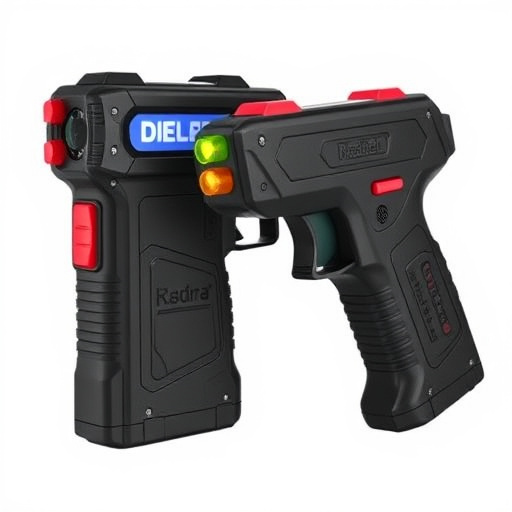Stun guns with alarms and lights (ECDs) are non-lethal weapons that temporarily paralyze targets through electric shocks, enhancing personal security. Their effectiveness depends on pulse frequency, balancing deterrence and potential side effects like muscle spasms. These devices significantly improve safety in low-light conditions with loud alarms and bright LED flashlights, allowing users crucial seconds to escape or defend themselves. Proper handling techniques, regular maintenance, and secure storage ensure their reliability while prioritizing user safety.
Stun guns, powerful tools designed for personal protection, utilize electrical pulses to incapacitate assailants. This article delves into the intricacies of stun gun technology, focusing on a crucial aspect: electrical pulse frequency. We explore how different frequencies impact effectiveness, range, and safety features, with a special emphasis on the integrated alarm and light systems found in many modern stun guns. By understanding these components, users can make informed decisions when choosing self-defense tools.
- Understanding Stun Guns: A Brief Overview
- The Role of Electrical Pulse Frequency
- Alarm and Light Systems in Stun Guns
- Safety Considerations for Stun Gun Users
Understanding Stun Guns: A Brief Overview
Stun guns, also known as electronic control devices (ECDs), are non-lethal weapons designed to incapacitate a target through electrical pulses. They work by delivering a strong electric shock that disrupts the nervous system, causing temporary paralysis and muscle contractions. This disruption prevents the targeted individual from moving or resisting effectively, providing users with a brief window of opportunity to control and subdue them.
Modern stun guns often come equipped with additional features like alarms and flashing lights to attract attention and deter potential threats further. These devices are commonly used by law enforcement, security personnel, and individuals seeking personal protection. The frequency of the electrical pulses plays a crucial role in determining the effectiveness and range of stun guns. Higher frequencies can penetrate certain materials and cause more significant disruptions, while lower frequencies may be less invasive but still powerful enough to incapacitate.
The Role of Electrical Pulse Frequency
The electrical pulse frequency in stun guns plays a pivotal role in their effectiveness and safety features, particularly when considering stun guns with alarm and lights. This frequency determines the number of electrical pulses delivered per second, measured in hertz (Hz). A higher frequency generally results in more powerful and rapid shocks, making the stun gun more effective against potential attackers. However, it also increases the likelihood of side effects like muscle spasms and temporary paralysis, which can be a concern for users’ safety and well-being.
Moreover, the integration of alarms and lights in stun guns adds another layer to the equation. These features often rely on specific pulse frequencies to function optimally. For instance, an alarm may trigger at a certain frequency to alert nearby individuals or deter attackers, while lights could be synchronized with pulses to enhance visibility and disorient the target. Therefore, the choice of electrical pulse frequency in these advanced stun guns is crucial for balancing effectiveness, safety, and the synchronization of various features like alarms and lights.
Alarm and Light Systems in Stun Guns
Stun guns equipped with alarm and light systems offer enhanced visibility and deterrence, making them valuable tools for personal safety. These features are particularly beneficial in low-light or dark environments, where users can quickly identify potential threats. The integrated alarms emit loud sounds to startle attackers, while bright lights temporarily disorient them, providing the user with precious seconds to escape or defend themselves.
Such stun guns often incorporate various lighting modes, including powerful LED flashlights, to illuminate surroundings and blind opponents momentarily. Alarm systems can also be customizable, allowing users to set sensitivity levels for triggers, ensuring false alarms are minimized while still responding promptly to genuine threats. These features not only make stun guns more effective but also give users a sense of security and control in potentially dangerous situations.
Safety Considerations for Stun Gun Users
Stun guns, while designed for self-defense, come with a set of safety considerations that users must be aware of to ensure their well-being and effective deployment. One of the primary safety features in stun guns is the inclusion of alarms and lights. These visual and auditory cues serve as warning signals to both the user and potential assailants. The loud alarm sounds and bright lights flash upon activation, providing a deterrent effect and alerting nearby individuals or authorities of an impending threat.
Additionally, proper handling and usage instructions are crucial. Users should be trained on how to activate the stun gun correctly, ensuring they aim for specific pressure points as recommended by manufacturers. Regular maintenance and inspections are also essential to check for any defects or malfunctions, as a well-maintained stun gun is safer in the hands of its owner. Always keeping the device in a secure location when not in use, especially away from children and unauthorized individuals, further enhances safety measures.
Stun guns, powerful tools for personal safety, rely on precise electrical pulse frequency to disable attackers. Understanding the role of frequency, along with integrated alarm and light systems, is crucial for effective self-defense. By choosing stun guns with these advanced features, users can enhance their protection and ensure they’re prepared in any situation. Remember, proper safety considerations are essential when employing such devices.
